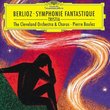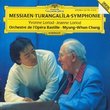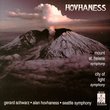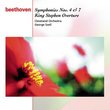| All Artists: Dmitry Shostakovich, Dimitri Mitropoulos, Eugene Ormandy, New York Philharmonic, Philadelphia Orchestra Title: Dmitri Shostakovich: Violin Concerto, Op. 99; Cello Concerto, Op. 107 Members Wishing: 1 Total Copies: 0 Label: Sony Original Release Date: 1/1/1956 Re-Release Date: 6/16/1998 Album Type: Original recording remastered Genre: Classical Styles: Forms & Genres, Concertos, Historical Periods, Modern, 20th, & 21st Century, Instruments, Strings, Symphonies Number of Discs: 1 SwapaCD Credits: 1 UPC: 074646332726 |
Search - Dmitry Shostakovich, Dimitri Mitropoulos, Eugene Ormandy :: Dmitri Shostakovich: Violin Concerto, Op. 99; Cello Concerto, Op. 107
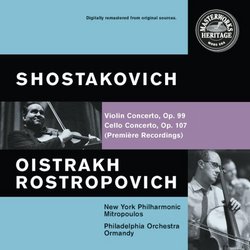 | Dmitry Shostakovich, Dimitri Mitropoulos, Eugene Ormandy Dmitri Shostakovich: Violin Concerto, Op. 99; Cello Concerto, Op. 107 Genre: Classical
Sony has brought together Shostakovitch's greatest concertos in first recordings made soon after their American premieres by the artists most closely identified with them. Neither performance has been bettered, though some... more » |
Larger Image |
CD DetailsSynopsis
Amazon.com Sony has brought together Shostakovitch's greatest concertos in first recordings made soon after their American premieres by the artists most closely identified with them. Neither performance has been bettered, though some, such as Vengerov's Teldec Violin Concerto, come close. The Violin Concerto is in solid, detailed mono; the Cello Concerto in fine stereo. Oistrakh goes to the heart of the violin work, playing with extraordinary tonal magnificence and emotional power. He's matched by Mitropoulos, whose identification with the score is apparent. Rostropovitch is as good in the Cello Concerto, getting excellent support from Ormandy's Philadelphians. Both performances share the white heat of fresh discovery and have stood the test of time to become classic recordings. --Dan Davis Similarly Requested CDs
|
CD ReviewsStunning Shostakovich Jeffrey Lipscomb | Sacramento, CA United States | 05/16/2005 (5 out of 5 stars) "Rostropovich in the Cello Concerto is superb and, without question, this is the greatest STUDIO account of the Violin Concerto. But please note: Oistrakh and Mitropoulos gave the American premiere of the Violin Concerto in a LIVE radio broadcast performance on New Year's Day 1956, and the studio recording on this Sony CD was made the following day. That LIVE premiere performance can be heard (excellent sound!) in a 10-disc box set from the New York Philharmonic called "The Historic Broadcasts 1923 to 1987." It's an expensive set ($225), but it contains some other extraordinary items, such as Stravinsky conducting Tchaikovsky's 2nd Symphony, Artur Rubinstein's finest account of the Chopin Piano Concerto #1 with Bruno Walter, Kirsten Flagstad and Walter in an incredible Immolation Scene from Wagner's Gotterdammerung, Stokowski's only recording of Mendelssohn's "Scotch" Symphony, and a great performance by Heifetz with Toscanini of the Brahms Violin Concerto. While I'm not a great fan of Heifetz, this was his finest account of the Brahms. But the REAL highlight of that NY Phil. set: the SUPERLATIVE performance by Oistrakh and Mitropoulos in the Shostakovich Violin Concerto. While this Columbia studio recording is indeed wonderful, it doesn't quite touch the inspired intensity of Oistakh's "live" premiere. Of course, not all "live" performances are better than their studio counterparts (e.g., I much prefer Sviatoslav Richter's studio Liszt concertos on Philips to his "live" concert recording on BBC Legends). But Oistrakh and Mitropoulos in the premiere tightened the screws and threw off sparks "live" that even this superb studio performance doesn't quite match. This Sony Columbia Masterworks CD is worth its price just to have the outstanding account of the Cello Concerto with Rostropovich. But if you want to hear Oistrakh's interpretation of the Violin Concerto at its absolute zenith, you should try to hear the NY Phil. set too. Highly recommended." Absolutely the best recording of the violin concerto J Scott Morrison | Middlebury VT, USA | 02/01/2000 (5 out of 5 stars) "Say what you will about modern recordings of the Shostakovich Violin Concerto No. 1, Op. 99, this recording, its first, is the best. In fifty years of collecting records, I put this in the top ten of any recording I've ever owned. Oistrakh, its dedicatee, and Mitropoulos and his New York orchestra played with unparalleled intensity. The Passacaglia, the heart of the work, is played more slowly than in modern recordings, and with a fervor that burns itself into your heart. The Cello Concerto is also given a classic performance by Rostropovich and Ormandy; Mason Jones, first horn of the Philadelphia Orchestra, plays the very important horn solos brilliantly." Getting It Right the First Time D. J. Zabriskie | Park Ridge, NJ USA | 05/21/2004 (5 out of 5 stars) "This is a wonderful pairing of two of the great Shostakovich
concertoes. If I could award it 6 or 7 stars I would! These are the "premiere" recordings of these works in the West, and nothing has quite equalled them in their brilliance of conception and execution since. We are presented with the marvelous gifts of hearing these pieces played by the soloists for whom the composer wrote them, and the rewards are thrilling and unsurpassed. As noted elsewhere, David Oistrakh was one of the half dozen or so greatest violinists of the 20th Century, and besides his flawless technique he exhibits the warmth of tone, the sensitivity, the flexiblity and the overall musicality which set him apart as a performer. For his part, Dimitri Mitropoulos accompanies his soloist with the type of genius too few conductors bring to this piece. Very few conductors were as gifted as Mitropoulos in looking at an unfamiliar score, imagining it whole and realizing that conception with brilliance. Despite the monoural sound, the New York Philharmonic has seldom sounded better.Likewise, Mstislav Rostropovich was one of the half dozen or so greatest cellists of the last century. Only Casals, DuPre and Yo-Yo Ma deserve to have their names mentioned along with his. Rostropovich brings similar musical gifts to his reading of the cello concerto as Oistrakh brings to the violin concerto, together with a personality which expresses both the humor and the fatalism of Shostakovich with such subtlety, it takes a while for the listener to appreciate it all. Yet the real revelation here is the conducting of Eugene Ormandy. This is Ormandy before he began to play it safe, and concentrated more on lushness of orchestral tone than in challenging his listeners. While that glorious "Philadelphia sound" is present throughout the cello concerto, it is well contained and well directed, and always at the service of both the soloist and the music.If you can find any recording of either of these concertoes that comes up to these, please let me know." |

 Track Listings (8) - Disc #1
Track Listings (8) - Disc #1
